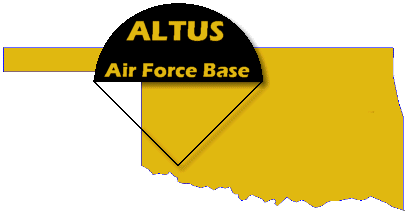

| Lets start this off right. Altus AFB
was the asshole of the world and probably still is. In the second
World War it trained B-25 pilots who were happy to go to war just to get
out of the place. In the 60's it had the worst alcohol abuse record
in the Air Force not to mention all kinds of other morale problems.
The people in the local town treated us like crap (especially the woman)
and the Base probably destroyed more potential Air Force careers than any
base in the Air Force. The Air Force in it's great wisdom left this base
opened in the cut backs last decade but shut down the two best bases in
the Air Force, Lowry and Hamilton.
Had it not been for skydiving I probably would have gone nuts in the place. The movies, drinking and watching TV was all there was to do usually, but I didn't drink and there were only 2 TV channels. The Altus Hotel on the town square had a cat house on the third floor and for $10 you could get a quickie but most of us airman made $80 a month then and that was big money to us. Too big... Despite the fact that three railroads ran through this pit of 25,000 bored people, passenger service had been discontinued and you had to take a bus from Oklahoma City to Lawton and a station wagon limo type thing to Altus. The bus to Lawton used the Katy RR station as a bus depot after the Katy got permission to stop the railroad passenger service. I bought a train ticket from Allenhurst, New Jersey to Chicago, to Kansas City to Lawton but when we got to Oklahoma City we were put on a bus. I wasn't happy about that. I missed the last train by a couple of weeks. At Lawton the Altus Limo waited outside and was an outrageous $7 for 75 miles! I got to Altus 90 minutes later and found someone from the photo lab, Airman French. French nor anyone else at the photo lab had any idea that I was coming or when. French however had what we now call ESP and he knew and was there to meet me! There was no bus station in Altus and the limo ended its run at an old ratty gas station just east of the town square on Highway 72 or whatever it is in town. (At least they could have terminated the bus at one of the three passenger railroad stations in town.) That gas station and a B-47 in the park nearby are my first memories of the place. I do remember looking at the miles and miles of nothing but nothing but I figured that if nothing else this place was one huge drop zone. A stark contrast to the heavily wooded area I grew up in. At least Colorado had those great mountains. In those days when you hit a new base you immediately went to the seat of wisdom concerning skydiving...the base parachute loft! If there weren't any riggers who jumped, they knew who did because they packed your reserves on the side. It was usually $1.50 to as high as $3! Outrageous! :-) I found one pro-skydiving rigger who actually grew up in this part of the State and apparently I was it! In those days we were James Dean types. Skydiving wasn't a team sport, we were rebels who jumped alone then partied together. You could say we were Rebels with a cause and a Chute Shop catalogue. :-) I was considered a daredevil in high school for jumping. I was both admired by some and beaten up by the phony loud mouth bullies who never would have had the guts to jump. The only relative work up till then was a baton pass which was considered a great feat at the time. Passing the baton was also the way you proved you actually made contact. (Things were changing though.) This did get carried too far thought. For a while people were passing everything! At Lakewood they passed a boa constrictor! Other animals with little parachutes on them like dogs, cats and even a pig were passed! Baseball bats, pogo sticks, rifles, lawn chairs etc. were taking to the air au masse all over the country! In California they even tried to pass a beach umbrella! The idea was to pass it, then open it so it would float safely to the ground but they dropped it and it fell to the earth like a lance! It pierced the drop zones' roach coach like a laser bomb and wiped out 4 cases of RC Cola!! In Texas, some fool had a 30-06 rifle passed to him and then he fired it! He got an instant lesson in Newton's law of opposite and equal reactions. Another cute trick was to jump with a static line in you hand and you pass- ed it to another jumper. He snapped it onto his reserve D-Ring and opened up! When he got line stretch it opened your rig. All well and good but picture what happens if you have a snibble with this guy directly under you! And if you didn't make the pass you had to haul in the static line like mad to open yourself! It was, however, early rel-work. The most idiotic stunt was when Ron Pack jumped with just a harness on and the other jumper passed him a reserve. He got his pilot a nice fine, but they couldn't legally touch him and he got a 10 minute spot on the Johnny Carson (TONIGHT) Show. Cartoons in Parachutists had him attempting to jump with no rig and just a pogo stick for landing! :-) Style and accuracy were the in thing. It was usually one pass-one jumper and if you did get out with someone else it was to save gas, money or to do a baton pass. By 65, however, two or more man attempts were happening on a regular basis. The rigger, whose face I can remember but whose name I can't remember to save my life, said that there was a club on Base at one time but everybody left or got out of the Air Force except him. He gave me a box with some PCA stuff and a bunch of patches, called an on the spot meeting of the club and elected me team captain and club president! Two days after that another jumper also arrived, Rick Vassar C-2129, from California. The rigger sent him to me as if I was the grand fubah of the Base. Starting in January 1965 the Air Force required all skydivers to be members of the PCA or Parachute Club of America. I was "raised" in a commercial world and I didn't know anything about licenses and the like. I just had a log book, a B-4 rig and a shit eating grin. I joined immediately and got my B-License which was a big thing then. It meant you were a real skydiver, eligible for the attention, admiration and sexual favors of the DZ groupies, but not a guru yet. There were no skygods then. Everyone was a hero! One problem though concerning the groupies.... Altus and Ft Sill are so far out in the boonies that the only groupies were prairie dogs and the odd buffalo!
Rick lived off base so it was up to me to build a local following. I hustled and eventually got 5 guys in the barracks to take a 1st jump course (Ken Beagle, Vern Lee Miller, Chuck Albright and two guys whose names I can't remember. These last two took the course but never jumped) In the mean time another B-License jumper, Norm Tiller, came to Altus. He in turn got his room mate, Eric Gueiss to start jumping. The clan was gathering and with a B-License I was the chief instructor! Next was where to jump? We had three real jumpers and six students but no DZ. My squadron barracks was the Headquarters Squadron and we supported all kinds of odd professions that were too small to have their own units. We had the "control tower monkeys" down the hall and I talked one guy into letting me use the tower watts line to call all the military control towers in the area to see if they knew of any DZ's. The parachute loft people only told me about the club at Vance AFB which was over 3 hours drive away at least. We picked up the phone and hit it in one. Ft Sill in Lawton had an Army aviation base and a large parachute club with over 70 members! We called them and the three of us plus Eric Gueiss and Ken Beagle (Ken worked with me in the Base Photo Lab) went down to Ft Sill on Saturday March 20th 1965 and the Altus Parachute Club finally got into the air! Not bad actually, only 24 days to arrive, find people, start a club and get into the air! We all joined the Ft. Sill Club (I think it was $7 a year) but any students we trained had to be tested by the Ft Sill club first. My course, which was mostly the Telsan thing wasn't like the every night for a week course the Ft Sill club ran but since we all lived together we went over it again and again and again and everyone passed. The Ft Sill club also trained you in packing as part of the FJC which we didn't but we helped each other out and they jumped my B-4 or Rick's extra B-12 rig. This was common in those days and it relieved small clubs from legal liability if your chute didn't open. You packed it so it was your fault. Reserves were packed by a Post rigger and the FAA had no say in it because they were club rigs on a military base outside the FAA's control. I don't honestly remember how we worked it out. The rigger I mentioned earlier repacked our T-7a's for $1.50 and he may have had an FAA rigger's license besides the military one but I don't believe anyone really cared or worried about it. We never saw an FAA man the whole 16 months I was there! The Ft. Sill club jumped every saturday and sunday of the year weather permitting. 100 to 150 free jumps a year wasn't unusual for those guys. They used the DeHavilland U-1a (Single Otter) and the L-20 Beaver. We made that first jump from the Otter and it was the last. It was sent overseas that following monday and ended up in Long Bin, RVN. The Army bought 184 of these planes from the Canadian DeHavilland company and they were very popular in Viet Nam until the Huey's and CH-47's took over their roles. In Canadian Military Service the U-1 took over from the Norseman and was complimented by the L-20 Beaver. Oddly enough the metal Otter and the fabric Norseman were pretty close in performance and both used the 600hp radial engine. The Norseman took 10 jumpers (sitting) and the Otter took nine (sitting) but it had floor space for one or two more. In many ways thought the 1940's Norseman was superior than the 1960's Otter (see chart below)
The drop zone was large but hard as a rock. It was
so hard that the Beaver landed on it without leaving an impressions!
The target was canvas panels and no peas. You did a good stand up
or a good PLF or you hurt!
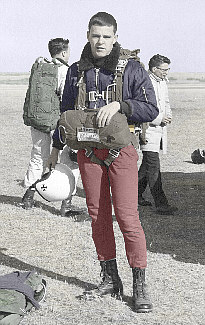 (The
photo to the left shows me waiting for that first load with Norm Tiller
with his rig/back to the camera. Notice the broken ankle cocking
out on my right leg. The weather was very cold but they sky was 100% clear.
Back then there were no jumpmaster qualifications. When the club
CSO thought you were ready to work with students, you got a bit of training
and you were a jump master. I was willing to train people but not
put them out and Rick did that. Spotting was the most sought after
skill for a jump-master. We went up in the Single Otter and since
it was my first jump with the Ft. Sill club they wanted a 5 sec delay.
Rick Vassar put me out. There wasn't even a target panel out that
day. The date was 20 March 1965. My mother died on this date
15 years later) (BELOW) a "Single OTTER" on floats.
Below that is a photo from Germany jumping a Beaver military style. (The
photo to the left shows me waiting for that first load with Norm Tiller
with his rig/back to the camera. Notice the broken ankle cocking
out on my right leg. The weather was very cold but they sky was 100% clear.
Back then there were no jumpmaster qualifications. When the club
CSO thought you were ready to work with students, you got a bit of training
and you were a jump master. I was willing to train people but not
put them out and Rick did that. Spotting was the most sought after
skill for a jump-master. We went up in the Single Otter and since
it was my first jump with the Ft. Sill club they wanted a 5 sec delay.
Rick Vassar put me out. There wasn't even a target panel out that
day. The date was 20 March 1965. My mother died on this date
15 years later) (BELOW) a "Single OTTER" on floats.
Below that is a photo from Germany jumping a Beaver military style.
There was one other problem. The DZ was right next to the artillery impact area!!! To the north was an Interstate to Oklahoma City, open private land to the east but the west and south were for the artillery school! If they were out on a weekend you got good training for
skydiving in Viet Nam! I remember more than a couple of jumps where
I could see shells landing below me if we had a south wind and jump run!
The Chute Shop in Flemington New Jersey, was selling a modified Air Force MT-1 harness. The basic harness was for HALO jumps and not bail outs. The back and sides were enclosed like a vest (similar to the Pioneer student rigs at Lakewood) and it had "shot and a half" capewells rather than the "two-shots" on the B-4. The B-12's were also being surplused with shot and a halfs and all commercial rigs by then had them. The Sport Harness as they called it, was an incredible $24.95!!! And god was it comfortable! Besides being a better design, the chute shop also put sport pads at every connector point and places where the harness might rub especially under the quick ejector hardware. For another $9.95 I also got an extended B-12 container with it and started to jump the yellow hustler in it. I could afford it all then, I had a second strip on my arm (minimum time in grade) and I was taking home an amazing $87 a month!
For me it was different. I made friends with a Spanish AF Captain and he traded some portraits of his family (which I shot) for a ride in the two seat version of the Messerschmidt fighter, the ME-109G-12. I got .9 hours in it logged which was about a tank of gas. Many of the 109's had been re-engined from the Junkers jumo engines (The Germans didn't supply them with the Daimler-Benz DB600 of the day because they needed them but they supplied instead the Jumo). I don't honestly remember if it had the original German engine in it or a Roylse-Royce Merlin in it. The Spanish also continued manufacture of the 109's till 1955. They were "CASA's" as seen in the movie Battle of Britain as were the HE-111's, also with the Merlin engines. I remember most the power behind these things. The hottest thing I'd flown in had 600 horse power and 235hp for anything I'd actually flown but this thing had 2000HP!!! You felt it most on take-off and when changing power settings, there was no delay in excelleration, you felt it instantly. The bird also had no rudder trim and you had to keep constant pressure on the rudder except in a turn. The narrow landing gear made landing a precise act but despite all the propaganda about the 109's bad landings it must be said that the Spitfire also had the same width gear and also had many landing accidents. I got back the beginning of July but high summer winds
plagued us. They broke on July 24th and we rushed to Ft Sill for
several jumps in 5-10mph winds. We had high winds in Oklahoma most
of the time and transport problems to Ft Sill so we started to look locally
for a place to jump. It found us. Just south of us at Frederick,
the FBO owner called us about doing demo jumps and we traded demos for
free regular jumps at Frederick on a 1-1 basis. We did some demos
at Frederick starting on Aug. 15, 1965 and more at Elk City on Aug. 22nd
for the town festival. (We had jumped the day before at Ft. Sill so we
were getting around for a change) The demos made the local as well as the
Base papers.
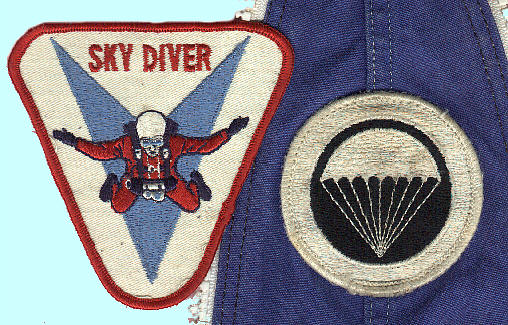
October 1965 was really windy in our part of Oklahoma and we only got to Ft. Sill twice for 4 jumps in the whole month. Half way around the world, however, an event was occurring that would change my life forever. 3 regiments of North Viet Namesse regulars hand come down the Ho Chi Minn trail in Laos, crossed into Cambodia and turned east right towards the Central Highlands of Viet Nam. The US Army had just deployed the 1st Calvary (formally called the 11th Air Assault) with it's "HUEY" helicopters at An Khe and Plei Me, commanded by Col. John B. Stockton. The NVA attacked Plei Me on Oct. 23rd and melted back into the jungle after a 6 day battle. They retreated to a newly fortified area on Chu Pong Mountain. On Nov the 14th an initial force of 175 men under the command of Col. Harold Moore landed in their Hueys at "LZ-Xray" in the Valley of the Ia Drang River (pronounced air drang) below the forts. Operation "Starlite" had begun. It was the first time the "Huey" was used in combat. The engagement lasted till November 20th and the first battle lasted 2 days and nights. The Americans killed over 1000 North Vietnamese regulars to a loss of 79 GI's. It was the first big engagement between the Americans and North Vietnamese and the war was on in full. The USMC had been using H-34's and the CH-37 before this but this was the first test for the HUEY and the air cavalry concept. After the initial contact and losses the NVA retreated into their forts and were pounded for the next 6 days by B-52's based on Guam. The NVA Regulars eventually abandoned their positions to the Americans and disappeared into the jungle. The Americans left a regiment at LZ-Xray who were to patrol 2 miles north to LZ-Albany where they were to be picked up by more Huey's. The HUEY immediately proved itself not only as an air assault vehicle, but as a gun ship (7 were kept on station during the battle) and freighter that brought supplies in and wounded out. The group that was left behind, however, did not have HUEY support. The local Communist Commander picked up on this quickly, regrouped his forces and ambushed the regiment with a force 3 times it's size and wiped it out to the man. Fat cats in the Pentagon rushed to the scene and saw the HUEY and air mobile combat units as a way to win the war in Viet Nam (while ignoring the total loss of the left behind regiment). A build up was on and I would be swept up into. In February 66, SSGT. Art Bishop B-4698 arrived on base.
He had less jumps than I but Jimmy treated him better in the club because
he had 2 more strips than I did even though I was team captain.
.
I also went to the 2nd Air Force Championships in January 66, where I took the accuracy title. It was quite accidental, I was on a TDY to Barksdale AFB and I heard about the meet. The last jump nailed it and I nailed myself good... see photo to see why! I was favoring my broken right leg and ankle and hammered in. Notice also that I have a new jumpsuit and French boots! At a dinner on Base I won a Swiss watch as a door prize but I had the exact same watch on my wrist so I sold it for $25 and ordered boots from the Chute Shop at $29. I also bought a blue Pioneer double zip jump suit in the same mail order. Also notice there's no peas under the target!
Before the Frederick jumps came through we found a small strip 10-15 minutes south of the base in a little town with 10-12 buildings (I believe it may have been the town of Oluste). The area was full of these little strips and they were built as emergency landing strips during the war for all the training bases around like Altus and Frederick. One guy in my barracks was a top pilot. He rented a bi-plane at Altus airport every pay day for aerobatics. This had a strange effect on base. The Air Force pilots either shunned him or admired him. The better pilots knew his skill and shared his feelings for the air and even occasionally flew with him. He found the strip from the air when he was flying. In our never ending search for the perfect DZ, we drove out the next (very windy) weekend and found it in good condition and figured someone was keeping it up and asked at the little general store. She said anyone could use it. The pilot (whose name I'm embarrassed to say I've forgotten) cut us a deal, he'd rent what he could, fly it out and back and we'd pay only 2/3rds the tach time for the actual jumps. He showed up with a Cessna 150!!!! We took the door off and each of the B-License holders (Rick was on "alert" that weekend and didn't go with us) got one or two in, none of which we could log. No NOTAM, no CSO or ASO and no DZ. My spotting was usually excellent but getting out of that 150 was a new and difficult experience for me. We had no target and on my first jump I landed in a fenced field (they were all fenced) next to the airstrip. As I was field packing a small herd of cattle surrounded me! I suddenly realized that I was wearing a red jumpsuit and large animals that do rude things to bullfighters were closing the circle! I yelled out to my mates at the fence "DO THEY BITE?! Wrong social move! I didn't hear the last of that for a month. I remember yelling back to my mates when they broke up laughing, "hey fuckheads, I was born in Jersey City, I'm guanna be a shepherd?!" I later learned cattle are color blind and they were just used to getting fed whenever a human came into the field. Next jump I left the jumpsuit off. It was hot on
the ground and warm at altitude. I jumped in chinos and a shirt.
(see photo). The winds came up to 15+ and I was blown across the
road into a wheat field and boy was that farmer most pissed! If I
hurt any wheat it was probably enough for a cup cake!
In May 66, the base surplus depot had several lots of C-9 quarter panels! The "quarter-panel" was orange and white but rather than alternating gores the orange was in three groups like a big orange three bladed propeller. You can see the difference in those newspaper clippings. They also had pucker bands in the apex. We bid $15 for each lot (5 to a lot) and got two of them, the rest going to a surplus store downtown. That bloody cretin cut the lines off and sold um for car covers! We found all in our 2 lots were serviceable and my 5 were still in the original sealed Switlick shipping bags unopened! They were only seven years old and never used. I resold 1 to Ken Beagle and 2 to Vern Miller for a main and reserve and kept two. In the end I paid $1.75 each for my two. I turned one into a club reserve for our only T-10 and sent the other off to have a HUSTLER cut into it. It didn't get back before I got my orders to Viet Nam though. The Ia Drang Valley and LZ-Xray caught up to me and the buildup was on in Viet Nam. I got my orders four days after I mailed the 28 footer off to a civilian rigger that worked at Vance AFB, in Oklahoma (our guy had been transferred by then). I freaked! "I'm guanna die!"... then it hit me.... so what! I'm getting out of this fucking place!!! 16 months of hell with no leave was enough! I called the rigger on the "watts line" and had him mail the modified chute to my family home in New Jersey when it was done. It beat me there and I didn't even open the box till I got back from Nam. The head of the photo lab, Sgt. Lapp also freaked! When I arrived at Altus, there were 7 of us before he arrived. In the last 6 months, Chaffin had been discharged, then Louie Wickliff got discharged and headed to Brooks Institute in Santa Barbara for College and a S/Sgt. (whose name totally escapes me) was transferred, Ken Beagle was getting out in two weeks and French hadn't told them if he was reupping or not. I actually knew that he planned to get out and then go to a base where he wanted to get transferred to and reup during the grace period in the hopes of staying there. So with the arrival of Mike Garcia who replaced Chaffin, that left French, Mike and Fred Fox and they weren't sure of French. Lapp pulled every string to keep me there but I set a record processing out. They wanted me to stay and work till I went overseas but I talked to the "First Shirt" and then the Sqd. Commander and he, seeing that I had been denied leave for my whole 16 months there, cut me loose so I could get a month at home before I went to Nam. I left on June 11, 1966. My last jump in Oklahoma was at the Ft Sill Post Field on May 21, 1966 and it was a demo for Armed Forces Day. The morning load had been from an AC-1 Caribou but it was off for another demo with half the Ft. Sill Club in it and the afternoon show was 3 Beavers, all poorly spotted. It was to be a mass jump (18 of us) with smoke. I was in Beaver #2 and we were to jump when we saw Beaver #1 going. We were watching the other planes and not the ground and as soon as I got out and popped the smoke on my boot I realized the spot was totally off so I did an arched max-track for 45 seconds! It looked great from the ground with the smoke! I was not only the only one to the target, I was the only one on the inside of the fence! Big applause from the crowd and my ego was the size of Jack Benny's safe! The photos below show myself and Ken Beagle who was running ground crew. The Army gave us the photos and its amazing that the color hasn't changed a bit in 33 years! It was the last time I jumped the red jump suit and did it for color at the demo. Ken is wearing my new blue Pioneer Jumpsuit.
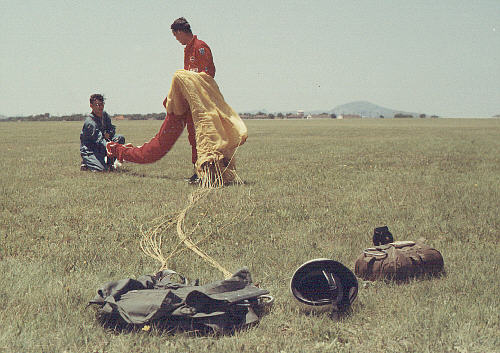 |
||||||||||||||||||||||||||||||||||||||||||||||||||||||||||||
|
|
||||||||||||||||||||||||||||||||||||||||||||||||||||||||||||
|
I'm sure the Army wasn't happy that the only one who got in was Air Force and Jimmy Ruiz was on the Caribou someplace else and heard about it when he got back. Jimmy, myself and Art were the only ones the Ft. Sill Club would let jump for the demo and I don't remember if Art was with us or Jimmy? Despite the fact I loathed Altus, I kinda hated to leave. We finally got the jumping going good and I had more friends than I had ever had in my life. Many military men were able to shut off their emotions about being trans- ferred and losing friends (or them being killed) OR they just didn't make any close friends. I wasn't that lucky. I kept close contact where I could and when Ken Beagle was killed in a boating accident in the Ohio River in 1970 I took it hard. He was my best friend in Oklahoma and probably the Air Force. When I got my orders to "The Nam" he was getting his discharge so maybe it was time to move on anyway. Not that I hadn't been trying all along. For over a year I volunteered for every base in Europe except Turkey and also tried for Japan where the rest of my Photo School class went. I was the only Stateside assignment in the class and we even had a guy in the class who lived 45 minutes from Altus and they wouldn't let us switch! I also ran into Louie in 1968 at Brooks Institute when I enrolled there.
Many jumpers especially in Northern California were experimenting with different cuts, especially changes to Dan Abbott's "Hooked" modifications. "Cheapos" (slang for surplus military canopies) were cheap then and the civilians could afford it. It cost $10-15 to have a rigger recut a modification into a round canopy or $25 to cut and tape a modification into a blank canopy. Also different was the fact that much of what you may have done was a first in the sport. I hold a 1967 world record that was set by accident! I may also have been the first person to every put a Hustler modification into a T-10 but we never planned it as some kind of a record. Everything was new, everything an adventure. The level of experimentation was 50X's what it is now! And it wasn't just gear. New positions were cutting seconds off style times and with slightly faster canopies, we were experimenting with up wind accuracy landings. Up till then you made an accuracy run down- wind or hooked a death-turn into the peas!!! Try that with a square in winds! The only exceptions to the rules were if you had the same wind or slightly lower that your canopies forward speed. You hooked a turn just right and tried to fall on the disc using your breaks to go forward or back. The Security CrossBow canopy actually had 4 toggle lines, the two extra front toggles gave you reverse thrust!! Dan kept this feature in the Mk I and II ThunderBows (a tri-angle canopy) but without the 2 extra lines. You went into "reverse-flight" but pulling the toggle lines down as far as you could. Many things are the same though, especially the feelings from doing some- thing for the first time. My first hook up was with no training. There was no RW training then! You moved about then by leg turns or dipping a shoulder and you moved forward by pulling in your arms or arching you back forward. With style training you learned to make fast turns with the impossible bending of your body like a lizard rather than getting in tight and turning with your limbs which is the present method. I got my first series under 10 seconds this way on New Years day 1966 at Ft Sill. Funny what you remember about those days. The funniest was the great "Hamburger jump Competition" May 16, 1965. The club went out and bought a ton of hamburgers at the Lawton McDonalds' (they were 17 cents then) and we were each given 20. You jumped from 3200 feet and made at least a 5 second delay. You then had to eat as many as you could while still steering the canopy. Your score was a combination of hamburgers eaten and accuracy! I got 3rd place and my stomach pumped! On my 33rd jump I did my first REL and did a very unusual thing for the day, exited holding another jumper but he couldn't get stable and I lost him. Such things were reserved for jumpers with 50-75 jumps but we were all military jumpers on a military base and got away with a lot of rule bending. Once, Jimmy Ruiz got pissed at me for something and did a put-up or shut up trip on me. I didn't have the B-License yet and I was the last one on the Beaver and spotted for myself the first time on my 30th jump. I did my best time series from 5400' I got 40 feet from the X in high winds. I was off the hook and he just said, "you did pretty good, maybe I was wrong." I also remember the first hook up. It was with Mike Wolberton (B-3329) and it was also the first time I ever exited unstable. We were told to roll out and get stable (as a training thing) and after we did, he flew a crude base and I grunted in. Rather than an actually hook up as we know it now we did a high-5 slap. That was a big thing then! The biggest problem was that he was about 2 feet higher than I was and as soon as we touched I slided backwards. Most of the real relative work was being done in California, probably more than the rest of the country combined. I don't know why really.. a synergy, good weather and no freezing temperatures on jump run??? If it was the weather than its interesting to note that a lot of the early big names then did move to California or Florida for the nicer weather. Ted Strong of Quincy, Mass. is a good example. There was also a difference in the styles of civilian and military clubs too, like different cultures. Unlike today, California was a great paradise where you
went to get away from the weather and the stuffy eastern culture.
Now it's outrageously priced, crowded and smoggy. Still better than
freezing your ass off in Michigan or Minnesota I guess.
The FIRST 6-way was formed over Pacoima, California
in summer 1965.
Taken at Ft. Bragg, you can see how close they are but there is actually a third jumper in the photo that's hard to see because of the need to reduce the photo for the Net. The lowest jumper is getting line stretch on his LoPo main and if you look in the nearest jumpers armpit next to the LoPo you can just make out a third jumper just starting to open! The photo is one of many magnificent shots taken by Sgt. Joe Gonzalas (US Army). Joe was also the official photographer for the 1962 world meet in Orange Mass.. He jumped with a rare rig, a 6x6cm (120 film) Hasselblad mounted on his helmet!! Never could figure how he wound it for the next shot?? You will also notice that the closest jumper has two pilot chutes attached to his sleeve. The single vs duel pilot chute issue was never settled and died a natural death when pull out pilot chutes settled the issue. Some jumpers said, especially ones who jumped at non-sea level DZ's, that you needed the extra chute. There was a problem in the old days of the pilot chute getting caught in the vacuum above your back and it was felt that with two pilot chutes bouncing around when the pack opened, one would hurl out into the air stream. I have to admit it did work but I didn't have much room in my container for two. At 6'2" I have a bad back-bubble problem and I had to open sitting slightly up to break the bubble. It worked nicely but increased opening shock because I was falling faster. When Guardian came out with their 3 foot tall pilot chute I grabbed one and it totally solved the problem. The thing didn't even have to spring out, if it just stood up to its' total length it was in the air stream. I still use it today. Thinking back, I remember when a new jumper asked someone why they put two pilot chutes in their rig, the standard answer was "because I can't fit three in!". Funny but the memories I have the most of Altus were the "packing parties" we had in the barracks' halls the nights after jumping. We had no packing tables. You tired the apex of the canopy to a broom that was wedged in the doors to rooms on each side of the hall or had someone hold tight and then someone else sat in your harness and leaned back while you "Flaked" the canopy. You held less pressure while you did the rest. It was good times talking, telling jump lies and generally socializing. No grog either, booze was only allowed in the NCO Club, Officers Club and in this one outdoor area near the barracks and was strongly enforced. It was also to attract attention to ourselves. If anyone had the idea of jumping they remembered the idiot packing in the halls and contacted you. In modern terms I guess we should have put up a sign that said "This intrusion into your personal space is brought to you by the Altus Sport Parachute Club!" Time erases the bad about some things, especially the total lack of female company for 16 months. I would like to go back someday just for the hell of it and maybe look at my old room and the hall where we used to pack. But then again, they say you can't go back and maybe the ghosts of the past are better left alone. Mourning for one's lost youth can be unpleasant. |
You could still buy 28' T-7 white or camo twill nylon mains and 24' silk reserves!!!!
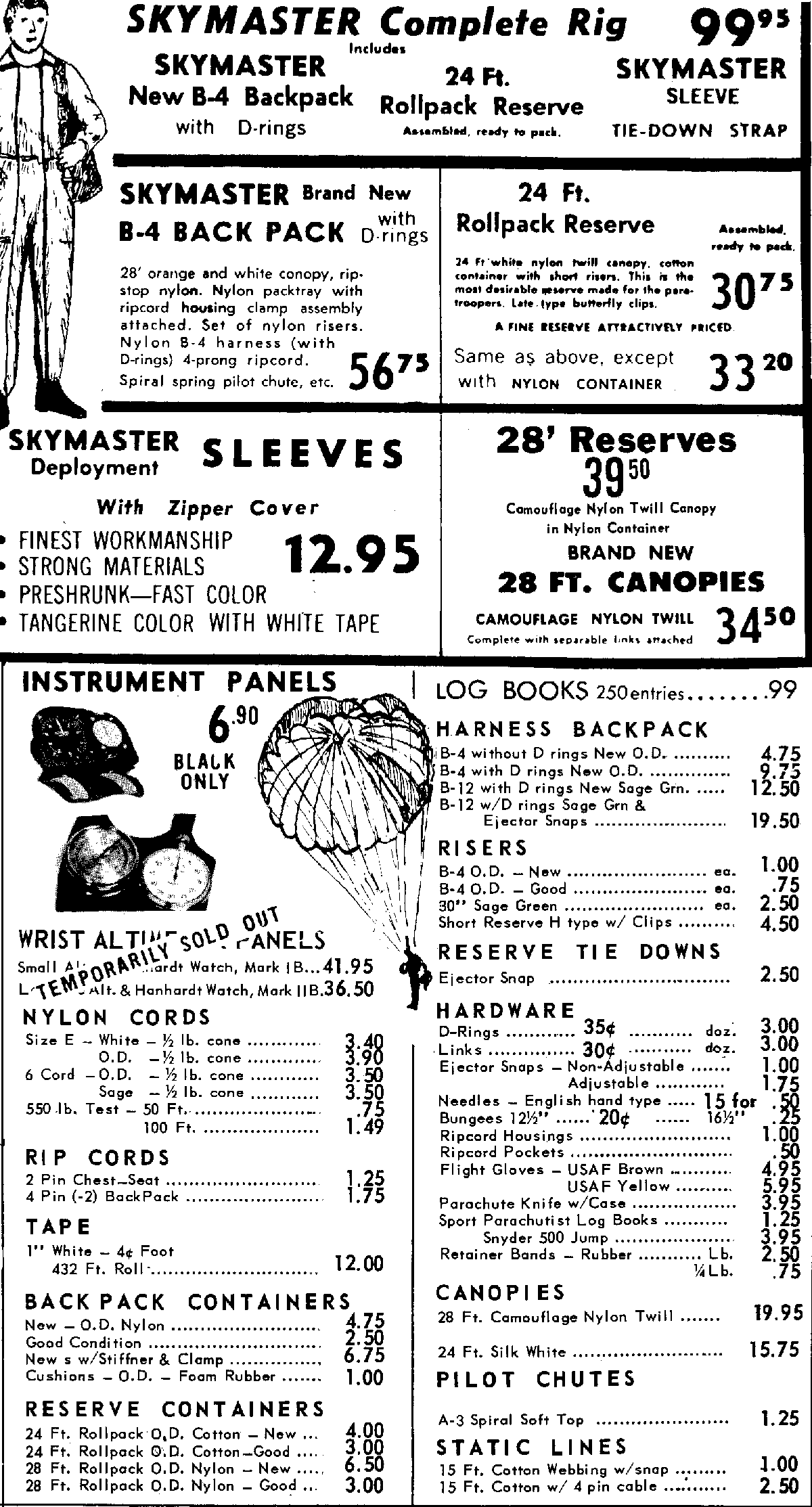
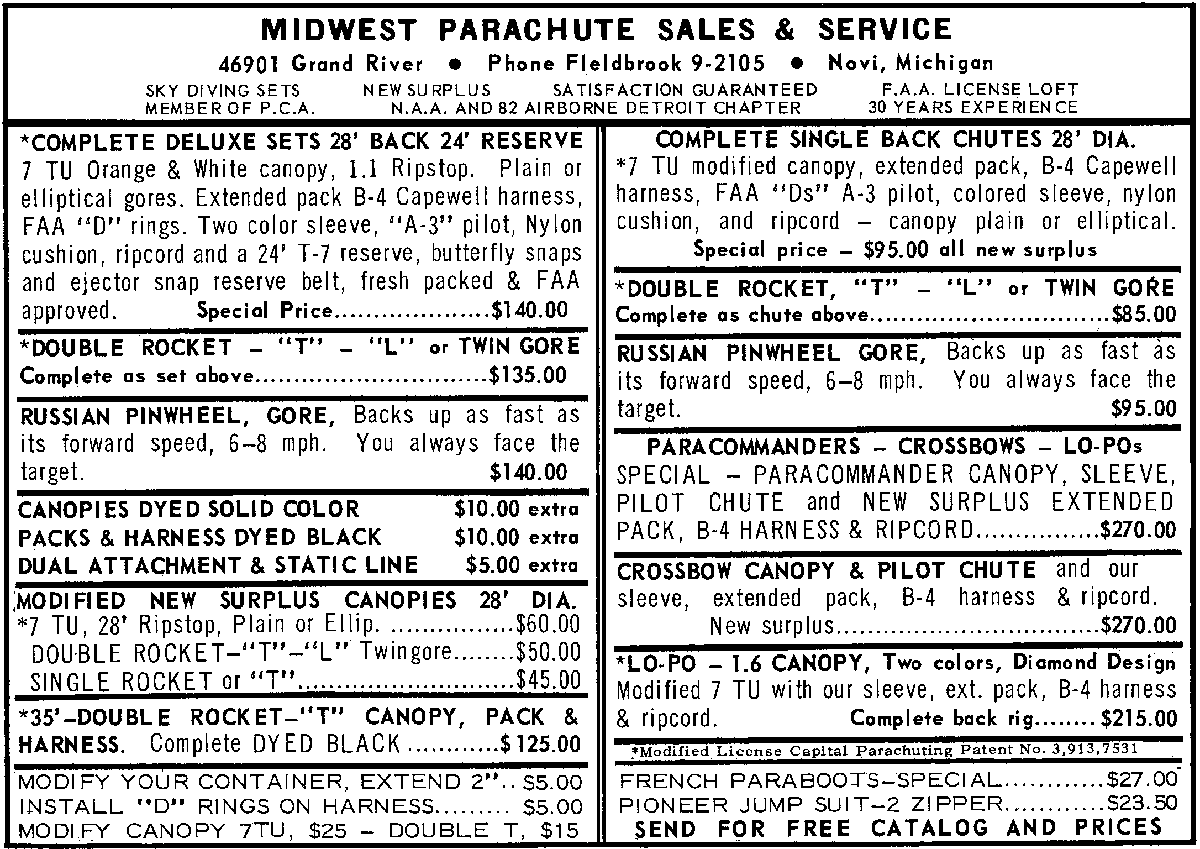
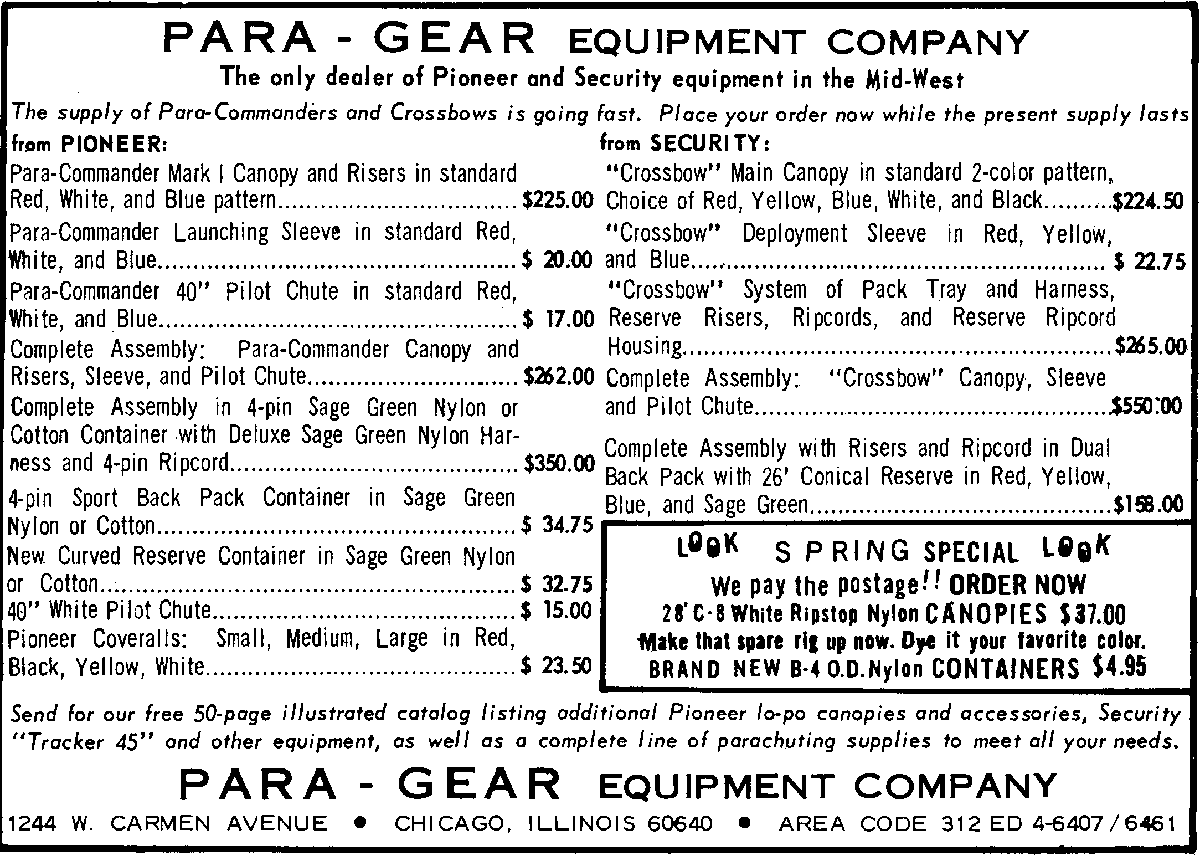 |
This page last revised on 10 January 2000